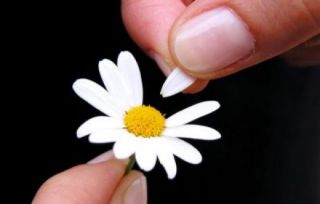Identity
He Loves Me...He Loves Me Not
What the latest research says about the benefits and risks of growing close
Posted May 7, 2013

The Benefits and Risks of Growing Close
In the 23rd installment of Sage’s Relationship Matters podcast, hosted by Dr. Bjarne Holmes of Champlain College, Dr. Jennifer Tomlinson (Carnegie Mellon University) discusses her recent research with Professor Art Aron (Stony Brook University) on the classic dilemma: how do we balance the benefits of growing emotionally close to a person with the risk of getting hurt that comes when we make ourselves vulnerable?
In terms of benefits, growing close to others offers an opportunity to expand who we are as individuals. For instance, a person you grow close to may introduce you to a certain type of music or a new hobby. As you grow close you’re more likely to expand who you are (i.e., add to your self-concept) by incorporating some of the newfound interests into how you view yourself – which in turn increases your interest in the person and your feelings of closeness. Most likely, the person grow close to is having a similar experience, leading them to want to become closer to you.
Tomlinson explained, “People have a natural desire to want to be close to other people and we get a lot of benefits from doing that. When we become close to another person we begin to include aspects of their self-concept in our own selves. We can become bigger people by including others into our own self-concepts”.
However, the flip side to opening up and growing close, especially in the early stages of a relationship, is that we make ourselves vulnerable to getting emotionally hurt. The researchers were interested in some of the mechanisms people use to balance the costs and benefits of getting close vs. getting hurt. “People have to make decisions as to whether to increase closeness to another person or to back away and be a little more protective”, said Tomlinson.
With this in mind, the researchers focused on the cues people use to help them decide whether or not to become close to another person. They tested two such indicators that people may look for in a partner: 1) how satisfied a partner seems with the relationship, and 2) how close to us the partner seems to feel.
So, what did they find?
It is how close to us the partner seems to feel that is the key to helping us decide how comfortable we are with growing close to our partner.
Tomlinson explained, “It seems that this idea that you perceive your partner to include you in their self and include you in their lives seems to be a key important factor that helps determine whether people feel safe increasing their closeness with a partner.”
My advice: Be cautious, but don’t be too cautious. As the relationship develops, don’t make assumptions. Instead, be emotionally bold and dare to openly and honestly talk to your partner about how you are feeling and ask them how they are feeling. Be aware that there are things going in both you and your partner that subconsciously send signals to your partner as to how close you feel to them. Consider having a fun discussion pointing out how each of you have gained or grown as individuals by being introduced to new things by the partner. Smile.
The podcast can be heard in its entirety here, and the full research paper can be read here.
A previous version of this article was published on ScienceofRelationships.com


